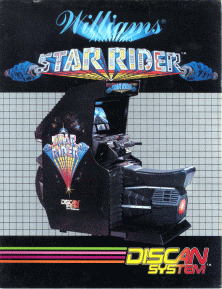Software:Star Rider
| Star Rider | |
|---|---|
 Sales flyer showing the arcade cabinet | |
| Developer(s) | Williams Electronics |
| Publisher(s) | Williams Electronics |
| Designer(s) | RJ Mical John Newcomer Python Anghelo |
| Programmer(s) | Richard Witt Ken Graham |
| Artist(s) | Python Anghelo |
| Platform(s) | Arcade |
| Release |
|
| Genre(s) | Racing |
| Mode(s) | Single-player |
| Arcade system | Williams 6809 Rev.1 Videodisk |
Star Rider is a racing LaserDisc video game developed by Computer Creations and Williams Electronics, and released for arcades in 1983. The object of the game is to win a futuristic motorcycle race that takes place in surrealistic settings. The tracks themselves and the background graphics are video played from a laserdisc, and are of higher quality than possible with real-time computer graphics at the time. The foreground graphics and racers are superimposed on the video. Star Rider has a rear view mirror—possibly the first racing game with one —which warns of opponents approaching from behind.[1][2]
Star Rider was produced in both an upright and a sit-down version where the player would sit on a replica of the cycle. It was released after the video game crash of 1983 and was not widely distributed. According to Eugene Jarvis of Williams, Star Rider was a "major dog" and resulted in or contributed to a loss of US$50 million.[3] The title character from Sinistar and a flying mount from Joust make cameo appearances in the background graphics.
Development and release
The game was conceived to compete with the laserdisc game Dragon's Lair which had just come to market.[citation needed] RJ Mical coordinated the project,[4] Python Anghelo was a co-designer, Ken Lantz directed software development, Richard Witt was the lead programmer, Ken Graham was a secondary programmer, and John Newcomer was the "creative director". The hardware was custom build specially for the game;[5] the laser disc video production was outsourced to a third-party company, Computer Creations, of South Bend, Indiana. The CGI graphics were rendered at Grey and Associates.[6] Witt and Lantz developed a means by which the first few lines of NTSC video signal contained data about the roadway, so that animated riders could appear to follow the track.
Star Rider was first demonstrated at the Amusement & Music Operators Association (AMOA) show in October 1983.[7] It demonstrated the use of pre-rendered 3D computer graphics,[1] which had previously been demonstrated by Funai's Interstellar[8] at the Amusement Machine Show (AM Show) in September 1983.[9] Star Rider was released in North America in November 1983.[10]
Reception
In the United States, it was the top-grossing laserdisc game at arcade locations on the Play Meter charts in August 1984.[11] It was later the top laserdisc game at street locations in November 1984.[12]
Legacy
In the 1987 slasher horror movie Blood Rage, two characters, Artie (James Farrell) and Gregg (Chad Montgomery), are seen playing Star Rider on a television set. Later, Artie and Julie (Jayne Bentzen) are seen playing the game but using joysticks to control the screen.[citation needed]
References
- ↑ 1.0 1.1 Gorzelany, Jim (April 1984). "Going Full Cycle". Video Games 2 (7): 24–29. https://archive.org/stream/Video_Games_Volume_2_Number_07_1984-04_Pumpkin_Press_US#page/n24/mode/2up.
- ↑ Arcade Alley Big K, 07 1984-Oct pp.72-73 [1]
- ↑ Hague, James (1997). Halcyon Days: Interviews with Classic Computer and Video Game Programmers. http://www.dadgum.com/halcyon/BOOK/JARVIS.HTM.
- ↑ "Work History of RJ Mical". http://www.mical.org/workhistory/.
- ↑ "System 16". http://www.system16.com/hardware.php?id=592&page=1#3083.
- ↑ "Interview with Ken Graham". https://nantucketebooks.com/ebooks/atgonzalez/Interview_With_Ken_Graham.html#INTERVIEW.
- ↑ "Cash Machine". Cash Box: 30–4. November 12, 1983. https://worldradiohistory.com/Archive-All-Music/Cash-Box/80s/1983/CB-1983-11-12.PDF#page=32.
- ↑ "立体CGを駆使したVDゲーム 〜 未来の宇宙戦争 〜 フナイから 『インターステラー』". Game Machine (Amusement Press, Inc.) (226): 24. 15 December 1983. https://onitama.tv/gamemachine/pdf/19831215p.pdf#page=13.
- ↑ "Overseas Readers Column: 21st AM Show Of Tokyo Held Heralding The Age Of The Video Disk". Game Machine (Amusement Press, Inc.) (223): 34. 1 November 1983. https://onitama.tv/gamemachine/pdf/19831101p.pdf#page=18.
- ↑ "Manufacturers Equipment". Cash Box: 34. November 26, 1983. https://worldradiohistory.com/Archive-All-Music/Cash-Box/80s/1983/CB-1983-11-26.PDF#page=34.
- ↑ "National Play Meter". Play Meter. August 15, 1984.
- ↑ "National Play Meter". Play Meter 10 (21): 28–9. 15 November 1984. https://archive.org/details/play-meter-volume-10-number-21-november-15th-1984-600DPI/Play%20Meter%20-%20Volume%2010%2C%20Number%2021%20-%20November%2015th%201984%20%28Compressed%29/page/28.
External links
- Star Rider at the Killer List of Videogames
- Star Rider page at the Dragon's Lair Project*
- Star Rider: Arcade Laser Disc’s Last Stand at The Arcade Blogger
- Star Rider Blu-Ray (2015) by Arrow Video
 |

